


The birds make their nests in a circle
because they have the same religion as we.
- Hehaka Sapa (Black Elk)





The birds make their nests in a circle
because they have the same religion as we.
- Hehaka Sapa (Black Elk)


Hitch-Hiker in Hades is the journal of a voyage taken by the author in 1980 by ship from Genoa, Italy across the Atlantic to Brazil. It relates the overland trip from Rio de Janeiro to Bahia in northern Brazil, the carnival there, a six-day trip up the Amazon spent mostly in a hammock, a sojourn in the Andes and the tropical region of Ecuador’s Pacific coast, and travels elsewhere in South and North America. Included are pen and ink drawings inspired by this voyage.It is not a customary travelogue, but rather a poetic Saison en Enfer (Season in Hell), a parallel descent to the classical underworld along with the descent to the equator. The antipodes of the book encompass the middle of the Amazon Basin and the streets of Manhattan, with references made to the works of other illustrious travelers: Catlin, Michaux, Lévi-Strauss and others. ”This inward space, then, is the subject of this hitch-hiker’s journal.”

Excerpts:Mediterranean Sea
on board the Eugenio
January 7, 1980
Dear C.,
What a day! We are now somewhere off the coast of Costa Brava, on our way to Barcelona, where we will take on passengers tomorrow at 8:00 AM. As I write, waves are smashing into the metal hull of the ship, one meter beyond my wall. My cabin is clean and luxurious, despite its third-class rating in the lower deck. The food is copious and good, and the wine flows abundantly. I have to choose: either to succumb to this abundance, or to start reading my book on Zen and take it easy. Zen and wine don’t mix.
Boarding the ship this morning in Genoa was pure chaos, in typical Italian style. I was given wrong information several times, sent on wild-goose chases in the city several times, but finally I was able to find the Eugenio in the huge harbor. Most of the passengers are Italians who have relatives in Brazil or Argentina. There are also two guys from Linköping who plan to take a boat trip up the Amazon. At sunset, off the coast of what I guessed to be Toulon, I climbed to the topmost deck (for first-class only) and experienced the incredible depth of the evening. I remember now why I wanted to take a ship – for those moments in the evening when the stars are slowly coming out and all that is a poet in me emerges.
I am rather tired now, but I want to start this letter, which I hope to add to over the days and then mail in Rio. After Barcelona we will stop, they say, in Lisbon, and then eight days later we arrive in Rio de Janeiro. The ship will then continue on to Santos and Buenos Aires. (The wind has picked up today, and outside the waves are really smashing against the side of the ship with a heavy thud. ) My experience has begun, and it is and will be so immediate, that I doubt if I will be able to write clearly about it. But I want to write anyway, so you can know a little of what happens day by day. I think I will lie down in my bunk now and resume tomorrow. P.S. We don’t stop in Lisbon after all. [...]
Salvador, February 19 The last night of c a r n i v a l . The city is now raging, as it has done for the past five days. Throbbing like a heart, it has been integrated into one rhythmic organ. Its thumping is distant now, as if covered by ribs, muscle and skin. I sit with a glass of cachasa, distilled sugar cane sap, trying to gather my wits. They have been shredded and strewn over the streets of Salvador like the confetti that hovers over the mud-filled main square, Praca da Se, trickling down over the heads of the dancing masses. My ego has been dissolved into the pulsating crowds samba-ing behind the trio electricos. I have become them. Now safe in my hotel room the throbbing noises from the city enter my window, as they have entered my soul, enchanting my imprisoned European spirit.
I must condense my vaporized wits. Throbbing in the veins and arteries of the city, the dancing people are like red blood cells seen under a microscope, moving rhythmically to the tempo of the samba. There is a vital secret flowing through the streets tonight in the rain – some elemental force like gravity or electro-magnetism which has not yet been named. The force that through the green fuse drives the flower , as Dylan Thomas called it.
The energy of this carnival is non-stop, continuing twenty-four hours a day. It has exhausted me. I felt the need, tonight, to remove myself from its radiation. I must fill my backpack once again, preparing for my departure tomorrow for Recife. My pen hesitates. What words can express the overpowering enchantment of the carnival? African answers "twang" from the room two doors down: "be-dwang dwang dwang, be-dwang dwang, dwang" - the steel wire stretched over the bamboo arch to the gourd of the berembao, struck with a stick and made to buzz against a coin. [...]
*
Atacames, Ecuador
March 15African people are a rare sight in Ecuador, since the slave trade brought them mostly to the Atlantic coast. There are many people of African origin around Atacames, however. They are possibly descendants of the thousand or so African slaves brought by Pedro de Alvarado from Guatemala in 1533, or those of a shipwrecked slave ship from Guinea bound for Lima, which crashed on a reef at the mouth of the Esmereldas river, some twenty-five years later. The survivors ran off into the forest and later founded villages and families of mixed African and Incan blood. [...]
1987
For years I have returned to Shalawa Meadow in Santa Barbara to see if the longed-for waves (ideal for surfing) were breaking on Hammond’s reef, and to observe the Chumash medicine circle claiming the field as sacred land. The local people know it as Hammond’s Meadow, after the people who bought the land in 1928. Most are yet unaware that the correct name is Shalawa, a large and ancient Chumash village in what is now the wealthy township Montecito.
The village sites have been totally developed, and now the burial ground of Shalawa, on a bluff overlooking the Santa Barbara Channel, is on the agenda for development. A persistent battle has been fought to save the meadow from Los Angeles developers, resulting in a halt of this desecration – for the time being. With the rapacity of the American Dream leaning heavily on the flimsy chain-link fence surrounding it, Shalawa is now experiencing the precarious safety of magic.
I often walk on the meadow and observe the seasonal transformations of the medicine circle of stones laid in regard to the cardinal directions, and was gradually struck with awe over this David-like defiance of Goliath big money, corrupt politics, vandals and grave-robbers. Here, the arrogant boast of Manifest Destiny does not reach the Pacific shore, but is obliged to stop one hundred meters short of it. The medicine is working.
George Catlin wrote much about encounters with ”medicine”. It is used all over the continent to denote ”mystery” or ”riddle”, and that is precisely how the medicine man, or any sane man, sees the universe – a mystery, a riddle. Thus the medicine circle on Shalawa Meadow is a microcosmic symbol for the entire universe.
After a year abroad, I returned to see the base of the painted medicine pole, in the center of the circle of stones, completely overgrown with the pungent-smelling power-plant called Momoy (datura). Large lily-like flowers, white with golden phalloi, adorned the luxurious growth, which covered the small offerings of previous years. Above, perched on each end of the cross-bar on the medicine pole, two small hawks watched for intruders, flying away at first eye contact.
Momoy (datura)
(In my mother's backyard)"Momoy is a dangerous plant that should not be used to induce hallucinations.
The dose that must be used to induce a hallucination is nearly the same dose that can kill."
(James D. Adams, pharmacologist at USC, News from Native California, Summer 2003)
Last week I walked from the beach up to the meadow, and the hawks again flew away when I looked up. Then I noticed a new transformation of the medicine circle over which they keep vigil. Momoy (Grandmother Momoy in the myths, who teaches the youth Yowoyow to be a good hunter and a man of spirit) has been removed and the entire circle cleaned and readied for the coming solstice ceremony. Top soil has been laid over the field to protect the graves, and the sacred inner space is raked in concentric circles as in a Zen garden, so that the artist could immediately tell by footprints if an intruder had been there.
His name in Chumash means ”obsidian”, and with his wife (whose name means ”dolphin”), he has been protecting the meadow from the ravages of developers, vandals, university-trained grave-robbers and rich senior citizens who allow their dogs to defecate inside the sacred medicine circle. He says the meadow has been a place of ceremonial gatherings since his earliest childhood, and back many generations to the ancient times of these dead ancestors buried here, among whose bones the many gophers now make their homes. [...]He has contacts with Native American communities all over the state and as far away as Montauk Point, Long Island, eastern gateway of the Atlantic to the Shinnecock people. The Chumash are the caretakers of the western gateway of the Pacific at Humqaq, now known as Point Conception, and the two tribes maintain ceremonial contact. Syukhtun was the largest and most influential of Chumash villages, the center of a culture which stretched from Big Sur to Malibu, and inland as far as the central valley. [...]
He was taken to Shalawa Meadow by the elders as an infant, when his training as a doctor began. (At that time he only recalls the tobacco ceremony being performed there.) He dislikes being called a ”shaman” and says he doesn’t know what this word means. He attended public school only because he was forced to. [...]
There has not always been a medicine circle on the meadow. In 1979 he became disgusted over local residents throwing litter, draining dirty oil from their cars onto the ground, vandalizing and robbing graves – they get $500 for a complete Chumash skull. [...] The Chumash cemetery had to be protected from the American Dream. ”Obsidian” put up a small painted medicine pole in the middle of the meadow, as if to say ”this is sacred ground.” When he returned the next day, the pole was stolen.
As the months went by, several replacement poles, successively sturdier and sturdier, were in turn stolen. In 1985 ”obsidian” and ”dolphin” made a small circle of stones around the medicine pole, which they took down after each ceremony to prevent another theft. Then they erected a very big brightly painted pole which thieves simply found impractical to steal. The vertical pole is the umbilical cord connecting the people to the earth mother Xutash. The horizontal cross-bar is the duality of the world. From colored yarn at each tip seagull feathers dangle in the wind. Seagull is the cleanser. Midway up the pole are deer antlers, and beneath these the bands of four symbolic colors: blue for Ocean, red for Earth, black for Owl’s Wing (sky), and white dots (Milky Way).
1989From a small circle of stones ten feet in diameter, the medicine circle has grown around the pole like ripples left in a calm lake after a pebble is tossed in. Now it is about forty feet across and the circle of large stones, very laboriously placed there by ”obsidian” and his helpers, surrounds twelve large boulders for the twelve months. He maintains these premises along with his wife, their children grand children and several other Chumash families. Along with his owl clan, there are three other clans now operating: Turtle, Blackbird and Northern Bear. These clans organize several ceremonies yearly. On Shalawa Meadow they celebrate the solstices and equinoxes. [...]
At the western approach to Shalawa Meadow ”obsidian” and his wife ”dolphin” have erected an artistically designed stone monument with colorful inlaid ceramic tiles adorned with lizards, birds and flowers around this inscription:
The Sacredness
of the land lies in
the minds of its people.
This land is dedicated
to the Spirit
and memory of
the ancestors and
their children.On either side of this inscription are two bas-relief dolphins in turquoise ceramic. A day or two after this monument was finished, vandals broke off the heads of the dolphins and the general defacement continues to this day. Over all this the painted medicine pole stands enigmatically with the two seagull feathers dangling in the wind from colored yarn, and the two tiny hawks perched on the cross-piece. One of these was tamed by ”obsidian”. The other is a wild friend. (Excerpt from Hitch-Hiker in Hades)
[Note: In his book Kuta Teachings John Anderson writes of the Chumash medicine pole Spon Kakunpmawa, ”pole of the Sun”, adorned with two long feathers from a condor, also a ”cleanser” like the seagull. The Chumash storyteller Kitsepawit (Fernando Librado), who spoke often with John Peabody Harrington at the beginning of this century, said that this pole was part of the ceremony surrounding death, burial and reincarnation. Personal possessions of the deceased were scattered around the base of the pole, located at a memorial shrine removed from the main village serving as a ”trap” to entice the dead soul away from the living and onto the complicated path of reincarnation. The dead person’s possessions had been burned except for those scattered at the base of the pole, so that the soul lingered at these shrines instead of in the villages, comforted by the many familiar objects.
Offerings beneath the monument
Santa Barbara Independent, May 31, 2018:
Chumash Attend Public Meeting on Sacred Site

In this way, the surviving family members were spared being haunted by ”ghost sickness”. The soul watched the shadow made by the medicine pole to orient itself on its way to Shimilaqsha, Land of the Dead. Anderson continues: ”These poles symbolized the ’climbing’ of the soul of the dead into the heavens on the celestial tree, the Milky Way.” He writes that catholic priests prevented these ancient ceremonies, forcing the Chumash to bring the deceased into the mission to lie in state beside two burning candles before being buried in a catholic cemetery. For this the priests charged the family an exorbitant fee, as did the priest in Ventura who told Kitsepawit that ”Our Lady of Los Angeles demanded that.”]
"It begins with a worm who is eaten by a bird. The bird is eaten by a cat whose self-satisfaction is disrupted by a mean-looking dog. After devouring the cat, the dog is killed by a grizzly bear who congratulates himself for being the strongest of all. About that time comes a man who kills the bear and climbs a mountain to proclaim his ultimate superiorty. He ran so hard up the mountain that he died at the top. Before long the worm crawled out of his body." $19 (209 pages)
The creator of the Shalawa Meadow Medicine Circle tells this Chumash story:

Medicine pole in disrepair
July, 2000

Fallen medicine pole placed beside monument
June, 2002
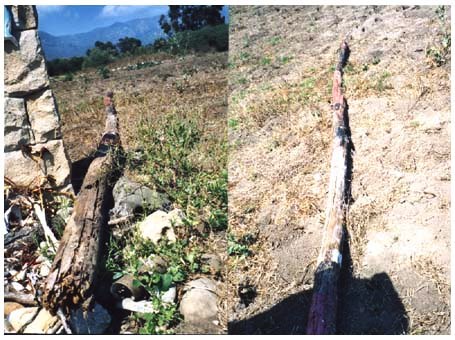
Fallen medicine pole with rotted base, beside monument
June, 2002
Bamboo replacement inside medicine circle
June, 2002

Bamboo replacement inside medicine circle
June, 2002


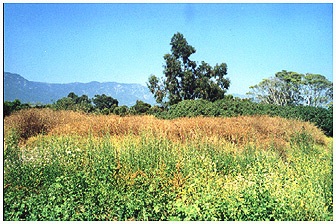
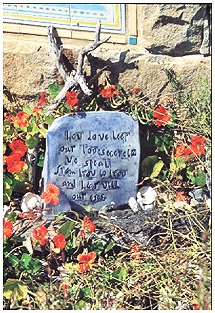


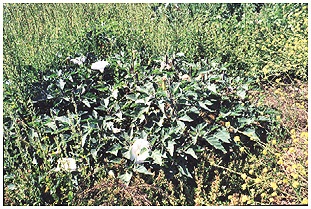

small circle of stones in the center of
the high brambles which now
completely fill the medicine circle



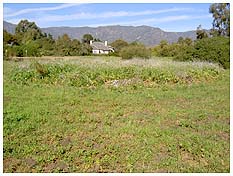




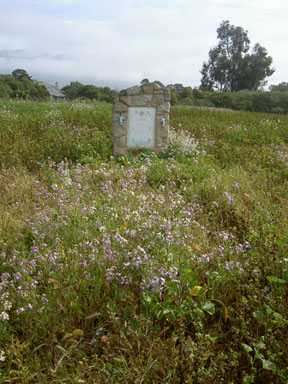


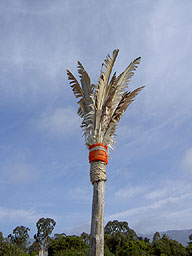
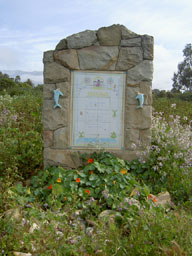
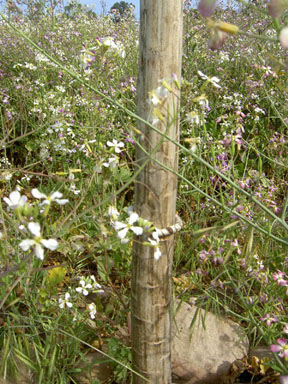

see also:
The Western Gate
The Eastern Gate
Anthropology Answerable
Turtle Island commentary
Everett Reuss
Syukhtun
Ishi


Home | Books | Sheet music for guitar | Visual arts | Biography | Syukhtun